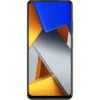MediaTek Helio G96

MediaTek Helio G96: Budget Champion for Everyday Tasks and Beyond
April 2025
The modern smartphone market offers a multitude of processors to suit every taste and budget. Among them, MediaTek Helio G96 stands out as an affordable solution for users who want decent performance without overpaying. Let's explore what makes this system-on-chip (SoC) noteworthy, who it is suited for, and what nuances should be taken into account.
1. Architecture and Technology Process: What's Inside Helio G96?
CPU: 8 Cores with a Focus on Balance
The Helio G96 is built on a classic heterogeneous architecture with two clusters:
- 2 Cortex-A76 cores with a frequency of up to 2.05 GHz for resource-intensive tasks (gaming, video rendering);
- 6 Cortex-A55 cores with a frequency of 2.0 GHz for background processes and energy efficiency.
This approach ensures smooth multitasking, but it falls short compared to chips with more powerful Cortex-A78 or Cortex-X1 cores.
GPU: Mali-G57 MP2
The Mali-G57 MP2 graphics accelerator with two compute units supports Vulkan 1.1 and OpenCL 2.0. This allows mobile games to run on medium settings, but without claims to ultra-graphics. HyperEngine 2.0 Lite technology optimizes network and processor load during gaming, reducing latency.
Technology Process: 12nm – Not the Newest, but Functional
The 12-nanometer manufacturing process (TSMC) ensures moderate power consumption (TDP 5W), but is less efficient compared to modern 6-7nm chips. This can affect heating during prolonged loads.
2. Performance in Real Tasks: Gaming, Multimedia, and More
Gaming: Moderate Capabilities
- Benchmark Results: In AnTuTu 10, the chip scores around 395,804 points, which is close to Snapdragon 680.
- Practical Experience: In Genshin Impact on medium settings (30 FPS), drops to 25 FPS are possible in complex scenes. Lighter games like PUBG Mobile or Mobile Legends run stably on high settings (60 FPS).
Multimedia: 4K and 120Hz Displays
- Support for 120Hz displays makes the interface smooth, while HDR10+ enhances color reproduction.
- Video encoding/decoding: 4K@30fps, but recording in 4K can cause overheating.
AI Applications: Basic Functions
The built-in APU (AI Processing Unit) accelerates scene recognition in the camera, automatic photo retouching, and voice assistant functionality. However, it lacks the power for complex tasks, such as real-time video processing.
Power Consumption and Heating
- Battery: Smartphones with G96 (e.g., Realme 10) are equipped with 5000mAh batteries, providing 7-9 hours of screen time.
- Thermal Package: During active gaming, the body may heat up to 42°C, but critical throttling (frequency reduction) is usually absent due to software optimizations.
3. Integrated Modules: Connectivity and Navigation
- 4G LTE Cat-24 Modem: Download speeds of up to 600 Mbps, uploads up to 150 Mbps. 5G is not supported, which becomes a noticeable drawback in 2025.
- Wi-Fi and Bluetooth: Wi-Fi 5 (up to 866 Mbps) and Bluetooth 5.2 with support for two devices simultaneously (e.g., headphones and smartwatches).
- Navigation: GPS, GLONASS, Galileo, QZSS – quick location determination even in urban areas.
4. Comparison with Competitors: Who It Lags Behind and Who It Surpasses?
- MediaTek Helio G95 (Previous Generation): G96 is 10-15% faster in games due to increased GPU frequencies.
- Qualcomm Snapdragon 680: Comparable in CPU, but Adreno 610 in SD 680 is weaker than Mali-G57 MP2.
- Unisoc Tiger T616: Falls short compared to G96 in energy efficiency and camera support.
- Snapdragon 4 Gen 2: A new competitor with a 6nm technology process and 5G, but with devices that are more expensive than those with G96.
Conclusion: Helio G96 is optimal in the $200-250 segment, especially if 5G is not a priority.
5. Use Cases: Who is This Chip Designed For?
- Gaming: Suitable for casual gamers. Hardcore gamers should opt for devices with Dimensity 9000 or Snapdragon 7 Gen 3.
- Everyday Tasks: Social media, streaming, working with office applications—all without lag.
- Photo and Video:
- Supports cameras up to 108 MP and dual modules with AI noise reduction.
- Records video at 4K@30fps, but electronic image stabilization (EIS) works only at 1080p.
6. Pros and Cons: What to Expect from G96?
Pros:
- Affordable device prices ($200-300).
- Supports 120Hz displays and high-resolution cameras.
- Stable performance in multitasking scenarios.
Cons:
- No 5G.
- Heating during prolonged loads.
- Limited GPU performance for high-end gaming.
7. Tips for Choosing a Smartphone with Helio G96
1. Cooling: Look for models with liquid cooling systems (e.g., Poco M5).
2. Display: An AMOLED display with 120Hz will unlock the chip's potential.
3. RAM: At least 6GB for comfortable operation.
4. Target Devices: Budget and mid-range smartphones like Xiaomi Redmi Note 12S or Realme 10.
8. Final Verdict: Who is Helio G96 Suitable For?
This processor is an excellent choice for:
- Budget Users who prioritize a smooth interface and support for modern displays.
- Mobile Photography Enthusiasts: Cameras with support for 108 MP and AI filters deliver good results for their price.
- Casual Gamers: If you’re not chasing ultra-settings, G96 can handle most popular games.
Key Benefits: Savings without serious compromises in quality. In 2025, smartphones on Helio G96 remain relevant due to the balance of price and capabilities, especially in regions where 5G is not yet a necessity.
Basic
6x 2 GHz – Cortex-A55
GPU Specifications
Connectivity
Memory Specifications
Miscellaneous
Benchmarks
Phones with Helio G96










Comparison of Devices with Helio G96
Compared to Other SoC
Share in social media
Or Link To Us
<a href="https://cputronic.com/en/soc/mediatek-helio-g96" target="_blank">MediaTek Helio G96</a>